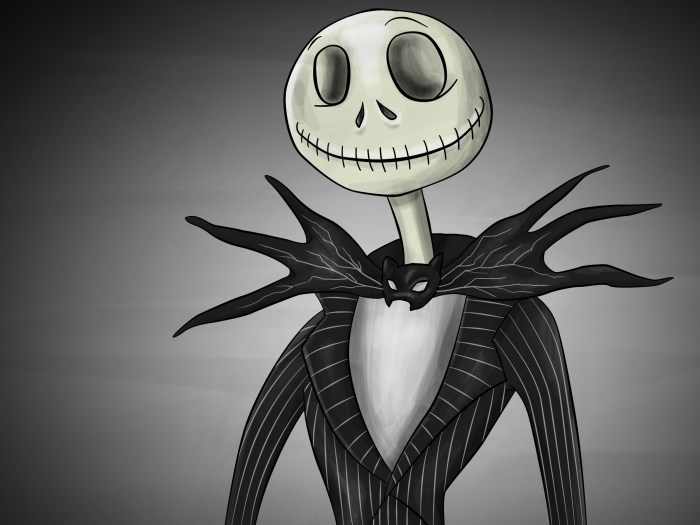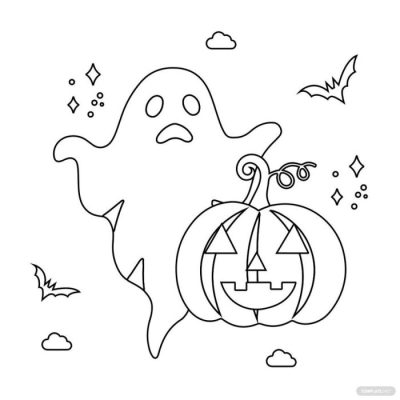Jack the Skeleton Drawing Easy with Axe

Composition and Background

Jack the skeleton drawing easy with axe – Creating a compelling drawing of Jack Skellington wielding an axe requires careful consideration of both the character and his environment. The background plays a crucial role in setting the mood and enhancing the overall impact of the artwork. Effective composition ensures visual harmony and guides the viewer’s eye through the scene.
Background Options for Jack Skellington
The choice of background significantly influences the atmosphere of the drawing. Three distinct backgrounds, each offering a unique aesthetic, are presented below.
| Background | Description | Mood | Color Palette |
|---|---|---|---|
| Halloween Town | The bustling, gothic architecture of Halloween Town, with its crooked buildings, cobblestone streets, and eerie streetlights, provides a vibrant and familiar setting for Jack. Details like swirling purple and orange skies, jack-o’-lanterns, and ghostly figures enhance the Halloween atmosphere. | Energetic, chaotic, yet familiarly spooky | Deep purples, oranges, blacks, with touches of muted greens and blues. |
| Spooky Forest | A dark and mysterious forest, with gnarled trees, shadowy paths, and perhaps a full moon peeking through the branches. The use of deep shadows and contrasting light can create a sense of foreboding and mystery. Perhaps a fog rolls in, adding to the ambiance. | Ominous, suspenseful, isolating | Dark greens, blacks, grays, with hints of moonlight silver and deep blues. |
| Graveyard | A classic graveyard setting, with weathered tombstones, overgrown vegetation, and a melancholic atmosphere. The inclusion of fog or a misty night adds to the eerie feel. The placement of tombstones can lead the eye to Jack. | Somber, reflective, classic Halloween | Grays, blacks, muted greens, with the occasional splash of moonlight or a flickering candlelight orange. |
Creating Depth and Perspective
Achieving depth and perspective is essential for making the drawing feel three-dimensional and engaging. Overlapping elements, atmospheric perspective (using lighter colors and less detail in the background), and linear perspective (using converging lines to create the illusion of distance) are all valuable techniques. Jack Skellington’s position relative to the background elements significantly impacts the sense of space. For example, placing him in the foreground with a distant, hazy background creates a strong sense of depth.
Conversely, positioning him within the background elements can create a more intimate and immersive scene.
Compositional Arrangements, Jack the skeleton drawing easy with axe
Three distinct compositional approaches can be used to create visually appealing and balanced artwork.
Composition 1: Rule of Thirds Jack Skellington, holding his axe, is positioned at one of the intersection points of the rule of thirds grid, creating a natural focal point. The background, perhaps a Halloween Town street scene, fills the remaining space, providing context without overwhelming the main subject.
The simplicity of a Jack Skellington drawing, perhaps wielding an axe, lies in its iconic design; the stark contrast of black and white makes it easily approachable for beginners. This ease of representation is mirrored in other simple architectural drawings, such as those found on sites dedicated to easy tutorials like this one for chateau elan drawing easy , which highlights similar principles of simplification for effective visual communication.
Returning to Jack, even adding small details like the axe enhances the character’s personality without increasing complexity, making it a perfect subject for practice.
Composition 2: Symmetrical Balance Jack Skellington is placed in the center of the drawing, creating a symmetrical balance. The background, such as a spooky forest, is arranged symmetrically around him, reflecting the central figure. This approach creates a sense of stillness and formality.
Composition 3: Asymmetrical Balance Jack Skellington is positioned off-center, perhaps leaning against a tombstone in a graveyard. The background elements are arranged asymmetrically, creating a more dynamic and visually interesting composition. The axe can be used to visually balance the asymmetry, leading the viewer’s eye through the scene.
Drawing Techniques and Styles

Depicting Jack Skellington, with his gaunt features and signature axe, offers a unique opportunity to explore diverse artistic styles. The choice of style significantly impacts the final piece’s mood and overall effect, ranging from whimsical cartoon interpretations to chillingly realistic portrayals. The careful consideration of line weight and variation further enhances the drawing’s depth and character.Three distinct drawing styles—cartoon, realistic, and minimalist—lend themselves well to illustrating Jack Skellington.
Each style presents a different approach to capturing his essence, offering a spectrum of visual interpretations.
Cartoon Style
A cartoon style allows for exaggeration and simplification of Jack’s features. His bony structure can be emphasized through exaggerated proportions, while his perpetually grinning expression can be rendered in a playful, almost comical manner. The axe, too, could be simplified into a basic shape, focusing on its iconic form rather than minute details. This style is ideal for capturing Jack’s playful yet slightly sinister nature, lending itself to a lighthearted interpretation of the character.
The lines would be bold and confident, with less emphasis on subtle shading or detailed textures.
Realistic Style
A realistic portrayal of Jack Skellington would involve meticulous attention to detail. His skeletal structure would be rendered with anatomical accuracy, showcasing the intricacies of bone structure and the subtle shadows cast within the hollows of his skull. The axe would be depicted with realistic textures, showing the grain of the wood and the metallic sheen of the blade.
This style aims for a photorealistic rendering, capturing a darker, more somber interpretation of the character. The lines would be varied in weight, creating a sense of depth and form through shading and cross-hatching.
Minimalist Style
A minimalist approach focuses on the essence of Jack Skellington using the fewest possible lines. The drawing would prioritize clean, simple lines to define his form, omitting unnecessary details. The axe would be represented by a few strategically placed lines, conveying its shape and function without excessive detail. This style emphasizes the character’s silhouette and form, creating a powerful and evocative image.
The lines would be consistent in weight, maintaining a sense of unity and simplicity throughout the drawing.
Line Weight and Line Variation
Line weight and variation are crucial for creating visual interest and depth in any drawing. Varying the thickness of lines can direct the viewer’s eye, emphasizing certain features and creating a sense of three-dimensionality. Thicker lines can be used to define the edges of forms, while thinner lines can suggest subtle details and create a sense of depth.
For example, thicker lines could define Jack’s jawline and the handle of the axe, while thinner lines could suggest the details of his ribcage or the blade’s sharpness. In a realistic style, cross-hatching and other shading techniques, utilizing varied line weights, can add depth and shadow to the drawing, making it appear more three-dimensional.
Step-by-Step Line Drawing of Jack Skellington
First, begin with basic shapes. Sketch a circle for the head, elongated ovals for the body and limbs. Then, refine these shapes to suggest the skeletal structure, adding pointed features for the skull, ribs, and joints. Next, add the simple, yet iconic, axe. Sketch a roughly rectangular shape for the axe head, connected to a longer, slightly curved shape for the handle.
Finally, add details such as the eye sockets, nose, and mouth, refining the shapes to accurately represent Jack’s characteristic features. Remember to maintain the proportions, keeping the body relatively elongated and the head proportionally large. This method of using basic shapes as a foundation allows for a more accurate and balanced representation of the character.
Adding Color and Shading: Jack The Skeleton Drawing Easy With Axe

Bringing Jack Skellington and his axe to life requires careful consideration of color and shading. The right palette can evoke the spooky charm of Halloween Town, while skillful shading will give your drawing depth and realism, or a stylized, almost spectral quality, depending on your artistic goals.Color palettes for Jack Skellington drawings can range from realistic to highly stylized.
A realistic approach might utilize a muted palette of grays, blacks, and whites for Jack’s bony structure, accented by deep blues and purples for shadows and highlights to emphasize his skeletal form. The axe could be rendered in dark browns and blacks, with hints of rust or metallic sheen. A stylized approach, however, might embrace brighter, more contrasting colors.
Think deep, vibrant blues for Jack’s body, perhaps with touches of glowing green or orange for an otherworldly effect. The axe could be a stark, almost neon, crimson or a shimmering, electric blue. The choice depends entirely on the desired mood and aesthetic.
Color Application Methods
Various methods exist for applying color to your Jack Skellington drawing. Colored pencils allow for delicate layering and blending, creating subtle gradations of color and shadow. Markers offer bold, flat colors and are excellent for achieving a graphic, comic-book style. Digital painting provides the most flexibility, allowing for experimentation with textures, blending modes, and a wide range of color options and effects.
Each method offers unique advantages depending on the desired final look. For instance, colored pencils might be best for a detailed, realistic rendering, while markers might suit a bolder, more stylized interpretation. Digital painting offers the broadest possibilities for both styles.
Shading Techniques for Form and Dimension
Shading is crucial for defining the form of Jack Skellington and his axe, creating a sense of three-dimensionality. For Jack’s bony structure, consider using a combination of light and dark tones to emphasize the curves and hollows of his skull, ribs, and limbs. Darker shading in the recesses will create depth, while lighter tones on the raised areas will highlight the form.
For the axe, use shading to define its handle, blade, and any metallic details. Consider the light source to determine where shadows should fall naturally. Cross-hatching, stippling, and blending are all effective techniques for achieving different shading effects. Cross-hatching involves creating a network of intersecting lines to build up darker areas; stippling uses small dots to create tonal variation; and blending, whether with a blending stump or digitally, creates smooth transitions between light and dark.
The choice of shading technique will influence the overall style and mood of the artwork.
Top FAQs
What materials are best for drawing Jack Skellington with an axe?
Pencils (various grades), charcoal, markers, colored pencils, or digital drawing software are all suitable options. The choice depends on your preferred style and skill level.
How can I make my drawing look more realistic?
Focus on accurate anatomy, detailed shading and highlighting, and realistic texture representation for both Jack and the axe. Observe reference images to guide your proportions and details.
What if I’m not good at drawing?
Start with simple shapes and gradually add detail. Practice regularly, utilize reference images, and don’t be afraid to experiment with different styles to find what works best for you.

